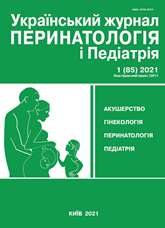State of respiratory function and features of airway inflammation in children with asthma combined with gastroesophageal reflux disease
DOI:
https://doi.org/10.15574/PP.2021.85.62Keywords:
asthma, gastroesophageal reflux disease, children, spirometry, induced sputumAbstract
The prevalence of gastroesophageal reflux disease (GERD) in children with asthma ranges from 32% to 80%. The intensity of respiratory symptoms, bronchial obstruction are more pronounced in children with asthma combined with GERD than in children with isolated asthma. However, there are limited and conflicting data on the difference between the induced sputum in asthmatic children with or without GERD.
Purpose — to examine the status of lung function and features of airway inflammation in children with asthma combined with gastroesophageal reflux disease.
Materials and methods. Sixty-seven children ages 6–17 years with moderate asthma and 30 healthy children ages 6–17 years were observed. They were assigned to three groups: group 1 (32 children with isolated asthma), and group 2 (35 children with asthma and GERD) and group 3 (30 healthy children). All children included in the study were identical in age and gender. Clinical assessment, spirometry with test of reversibility of airway obstruction, and cytological analysis of induced sputum samples were performed on all patients. Upper gastrointestinal endoscopy was done in the asthmatic groups.
Results. There were 10 (28.57%) children in the 2nd group with first degree obstructive spirometry pattern and none in the 1st group of children. First degree restrictive spirometry pattern was more significant observed in the 1st group of children — 10 (31.25%) than in the 2nd group of children — 2 (5.71%) (OR, CI 95% 7.50 (1.50–37.57)). In the 2nd group of children, induced sputum had a significantly higher number of neutrophils, lymphocytes and macrophages compared to the 3rd group (p<0.05). Also the difference between these parameters were significant compared to the 1st group of children. The number of induced sputum epithelial cells in 2nd group was significantly less than in 1st group of children.
Conclusions. GERD negatively affects the parameters of lung function in children with asthma. Airway inflammation in children with asthma combined with GERD appears to be more significant compared to isolated asthma.
The research was carried out in accordance with the principles of the Helsinki Declaration. The study protocol was approved by the Local Ethics Committee of an participating institution. The informed consent of the child's parents was obtained from the studies.
No conflict of interest was declared by the authors.
References
Ahmed HA, Ashraf ES. (2017). Assessment of spirometry in Gastroesophageal Reflux Disease (GERD) associated asthma patients. Int J Adv Res. 5 (3): 119-123. https://doi.org/10.21474/IJAR01/3494
Ali ER, Abdelhamid HM, Shalaby H. (2016). Effect of gastroesophageal reflux disease on spirometry, lung diffusion, and impulse oscillometry. Egypt J Bronchol. 10: 189-196. https://doi.org/10.4103/1687-8426.184368
Antipkin YG, Lapshyn VF, Umanets TR, Kreposniak AA et al. (2019). Asthma is associated with eosinophilic esophagitis in children: is this comorbid pathology established? Proceedings of the All-Ukrainian scientific-practical conference: Modern issues of allergology: 3. URL: https://armed.org.ua/wp-content/uploads/2019/04/Tezi-Dnipro-redaktsiya-29-03.pdf.
Apenchenko YS, Gnusaev SF, Rozov DN et al. (2018). The course of asthma in combination with gastroesophageal reflux disease in children. Bulletin of new medical technologies. 25 (3): 7-14. doi: 10.24411/1609-2163-2018-16057.
Barril S, Sebastian L, Cotta G, Crespo A, Mateus E, Torrejon M et al. (2016). Utilidad del esputo inducido en la practica clinica habitual. Arch Bronconeumol. 52: 250-255. https://doi.org/10.1016/j.arbr.2016.03.008
Bongiovanni A, Parisi GF, Scuderi MG, Licari A, Brambilla I, Marseglia GL, Leonardi S. (2019). Gastroesophageal Reflux and Respiratory Diseases: Does a Real Link Exist? Minerva Pediatr. 71 (6): 515-523. doi: 10.23736/ S0026-4946.19.05531-2. PMID: 31129955. URL: https://www.minervamedica.it/en/journals/minervapediatrica/article.php?cod=R15Y2019N06A0515.
Global Initiative for Asthma. (2020). Global Strategy for Asthma Management and Prevention. URL: www.ginasthma.org.
Gupta S, Lodha R, Kabra SK. (2018). Asthma, GERD and Obesity: Triangle of Inflammation. Indian J Pediatr. 85 (10): 887-892. https://doi.org/10.1007/s12098-017-2484-0; PMid:29127618
Hunt R, Armstrong D, Katelaris P, Afihene M et al. (2017). World Gastroenterology Organisation Global Guidelines. Global Perspectiveon Gastroesophageal Reflux Disease. Journal of Clinical Gastroenterology. 51 (6): 467-478. URL: https://journals.lww.com/jcge/fulltext/2017/07000/world_gastroenterology_organisation_global.5.aspx. https://doi.org/10.1097/MCG.0000000000000854; PMid:28591069
Kim HY. (2020). Spirometry Results of Reflux Esophagitis in Asthma Reflux Esophagitis in Asthma. Japanese Journal of Gastroenterology and Hepatology. 4 (3): 1 5.
Naik RD, Vaezi MF. (2015). Extra-esophageal gastroesophageal reflux disease and asthma: understanding this interplay. Expert Rev Gastroenterol Hepatol. 9: 969-982. https://doi.org/10.1586/17474124.2015.1042861; PMid:26067887
Patterson, Johnston, Ardill et al. (2007). Increased tachykinin levels in induced sputum from asthmatic and cough patients with acid reflux. Thorax. 62: 491-495. https://doi.org/10.1136/thx.2006.063982; PMid:17251314 PMCid:PMC2117233
Puneeth M, Prashanth Kumar M. (2019). Effect of Gastroesophageal Reflux Disease on Pulmonary Function Tests. International Journal of Physiology. 7 (4): 175-178. https://doi.org/10.37506/ijop.v7i4.85
Downloads
Published
Issue
Section
License
The policy of the Journal “Ukrainian Journal of Perinatology and Pediatrics” is compatible with the vast majority of funders' of open access and self-archiving policies. The journal provides immediate open access route being convinced that everyone – not only scientists - can benefit from research results, and publishes articles exclusively under open access distribution, with a Creative Commons Attribution-Noncommercial 4.0 international license(СС BY-NC).
Authors transfer the copyright to the Journal “MODERN PEDIATRICS. UKRAINE” when the manuscript is accepted for publication. Authors declare that this manuscript has not been published nor is under simultaneous consideration for publication elsewhere. After publication, the articles become freely available on-line to the public.
Readers have the right to use, distribute, and reproduce articles in any medium, provided the articles and the journal are properly cited.
The use of published materials for commercial purposes is strongly prohibited.

